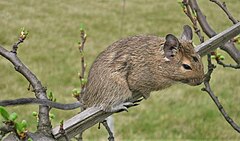Jeżozwierzokształtne
| Hystricognathi | |||
| Brandt, 1855[1] | |||
 Przedstawiciel infrarzędu – koszatniczka pospolita (Octodon degus) | |||
| Systematyka | |||
| Domena | |||
|---|---|---|---|
| Królestwo | |||
| Typ | |||
| Podtyp | |||
| Gromada | |||
| Podgromada | |||
| Infragromada | |||
| Rząd | |||
| Podrząd | |||
| Infrarząd |
jeżozwierzokształtne | ||
| Synonimy | |||
|
| |||
| rodziny | |||
| |||
Jeżozwierzokształtne[9] (Hystricognathi) – infrarząd ssaków z podrzędu jeżozwierzowców (Hystricomorpha) w obrębie rzędu gryzoni (Rodentia). Hystricognathi różnią się od innych gryzoni strukturą kości czaszki. Część mięśni szczęki przechodzi przez otwory podoczodołowe i łączą się z kośćcem po drugiej stronie. Również ukształtowanie i wielkość otworu podoczodołowego odróżnia Hystricognathi od innych przedstawicieli Rodentia.
Systematyka
Do infrarzędu należą następujące nadrodziny i rodziny[10][9]:
- incertae sedis
- Hystricidae G. Fischer, 1817 – jeżozwierzowate
- Thryonomyidae Pocock, 1922 – szczecińcowate
- Petromuridae Tullberg, 1899 – skałoszczurowate – jedynym żyjącym współcześnie przedstawicielem jest Petromus typicus A. Smith, 1831 – skałoszczur właściwy
- Heterocephalidae Landry, 1957 – golcowate – jedynym żyjącym współcześnie przedstawicielem jest Heterocephalus glaber Rüppell, 1842 – golec piaskowy
- Bathyergidae Waterhouse, 1841 – kretoszczurowate
- Erethizontoidea Bonaparte, 1845
- Erethizontidae Bonaparte, 1845 – ursonowate
- Cavioidea G. Fischer, 1817
- Cuniculidae – pakowate
- Caviidae G. Fischer, 1817 – kawiowate
- Dasyproctidae G.S. Miller & Gidley, 1918 – agutiowate
- Chinchilloidea E.T. Bennett, 1833
- Chinchillidae E.T. Bennett, 1833 – szynszylowate
- Dinomyidae Peters, 1873 – pakaranowate
- Octodontoidea Waterhouse, 1840
- Abrocomidae G.S. Miller & Gidley, 1918 – szynszyloszczurowate
- Ctenomyidae Lesson, 1842 – tukotukowate
- Octodontidae Waterhouse, 1840 – koszatniczkowate
- Echimyidae J.E. Gray, 1825 – kolczakowate
Opisano również rodziny wymarłe w czasach prehistorycznych[11]:
- Adelphomyidae Patterson & Pascual, 1968
- Baluchimyidae Flynn, Jacobs & Cheema, 1986
- Cephalomyidae Ameghino, 1897
- Eocardiidae Ameghino, 1891
- Gaudeamuridae Sallam, Seiffert & Simons, 2011
- Kenyamyidae Lavocat, 1973
- Myophiomyidae Lavocat, 1973
- Phiocricetomyidae Lavocat, 1973
- Phiomyidae Wood, 1955
- Protophiomyidae Coster, Benammi, Salem, Bilal, Chaimanee, Valentin, Brunet & Jaeger, 2012
- Renefossoridae Mein & Pickford, 2008
- Tufamyidae Pickford, 2018
- Tsaganomyidae Matthew & Granger, 1923
Rodzaje wymarłe należące do Hystricognathi:
- Asteromys Ameghino, 1897[12]
- Balsayacuy Boivin, 2022[13] – jedynym przedstawicielem był Balsayacuy huallagaensis Boivin, 2022
Przypisy
- ↑ J.F. von Brandt. Beiträge zur nähern Kenntniss der Säugethiere Russland’s. 5. Abhandlung: Unlersuchungen uber die craniologischen Entwickelungsstufen und die davon herzuleiteten Yerwandtschaften und Classificationen der Nager der Jetztzeit, mit besonderer Beziehung auf die Gattung Castor. 2. Theil: Craniologische Charakteristik der einzeluen Nagergruppen. „Mémoires de l’Académie impériale des sciences de St.-Pétersbourg”. 6e série. Seconde partie. Sciences naturelles. 7 (2), s. 294, 1855. (niem.).
- ↑ J.K.W. Illiger: Prodromus systematis mammalium et avium: additis terminis zoographicis utriusque classis, eorumque versione germanica. Berolini: Sumptibus C. Salfeld, 1811, s. 89. (łac.).
- ↑ J.V. Carus: Handbuch der Zoologie. Cz. 1: Wirbelthiere, Mollusken und Molluscoiden. Leipzig: Wilhelm Engelmann, 1868, s. 109. (niem.).
- ↑ T. Tullberg. Über das System der Nagetiere. Eine phylogenetische Studie. „Nova Acta Regiae Societatis Scientiarum Upsaliensis”. Seriei tertle. 18, s. 274, 1899. (niem.).
- ↑ S. Schaub. Remarks on the distribution and classification of the "Hystricomorpha". „Verhandlungen der Naturforschenden Gesellschaft in Basel”. 64 (2), s. 395, 1953.
- ↑ Ch.A. Woods. What is a Hystrimorph–Hystricognath rodent?. „American Zoologist”. 16 (2), s. 268, 1976. JSTOR: 3882296. (ang.).
- ↑ M.C. McKenna & S.K. Bell: Classification of mammals above the species level. Nowy Jork: Columbia University Press, 1997, s. 34. ISBN 978-0-231-11013-6. (ang.).
- ↑ S.O. Landry. A proposal for a new classification and nomenclature for the Glires (Lagomorpha and Rodentia). „Mitteilungen aus dem Museum für Naturkunde in Berlin, Zoologische Reihe”. 75 (2), s. 300, 1999. DOI: 10.1002/mmnz.19990750209. (ang.).
- ↑ a b Nazwy polskie za: W. Cichocki, A. Ważna, J. Cichocki, E. Rajska-Jurgiel, A. Jasiński & W. Bogdanowicz: Polskie nazewnictwo ssaków świata. Warszawa: Muzeum i Instytut Zoologii PAN, 2015, s. 285–297. ISBN 978-83-88147-15-9. (pol. • ang.).
- ↑ C.J. Burgin, D.E. Wilson, R.A. Mittermeier, A.B. Rylands, T.E. Lacher & W. Sechrest: Illustrated Checklist of the Mammals of the World. Cz. 1: Monotremata to Rodentia. Barcelona: Lynx Edicions, 2020, s. 26. ISBN 978-84-16728-34-3. (ang.).
- ↑ J.S. Zijlstra, Hystricognathi Tullberg, 1899, Hesperomys project (Version 23.8.1), DOI: 10.5281/zenodo.7654755 [dostęp 2023-10-14] (ang.).
- ↑ F. Ameghino. Mammifères crétacés de l’Argentine. „Boletín del Instituto Geográfico Argentino”. 18 (7–9), s. 495, 1897. (hiszp.).
- ↑ M. Boivin, L. Marivaux, W. Aguirre-Diaz, M. Andriolli Custódio, A. Benites-Palomino, F. Pujos, M. Roddaz, R.M. Salas-Gismondi, N. Stutz, J.V. Tejada-Lara, J. Yans & P. Antoine. Eocene caviomorph rodents from Balsayacu (Peruvian Amazonia). „PalZ”. 96 (1), s. 138, 2022. DOI: 10.1007/s12542-021-00551-0. (ang.).